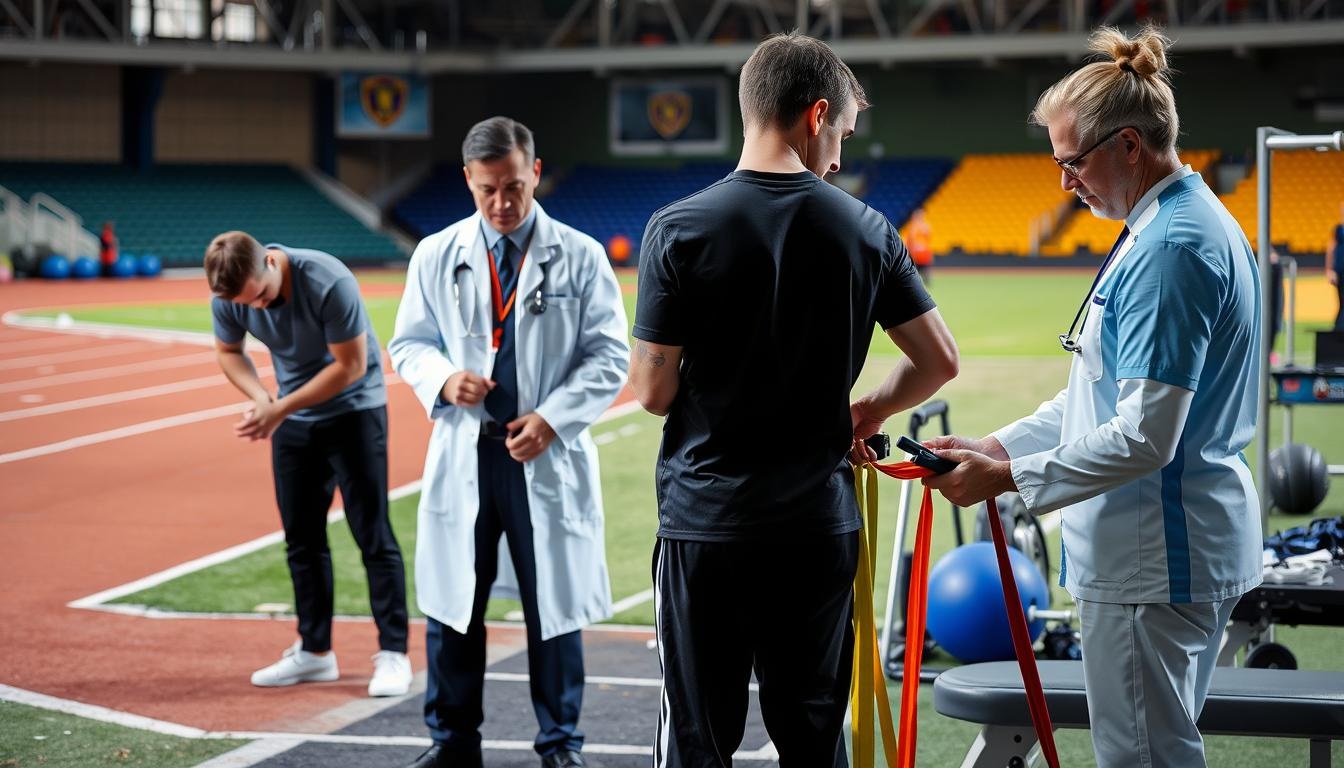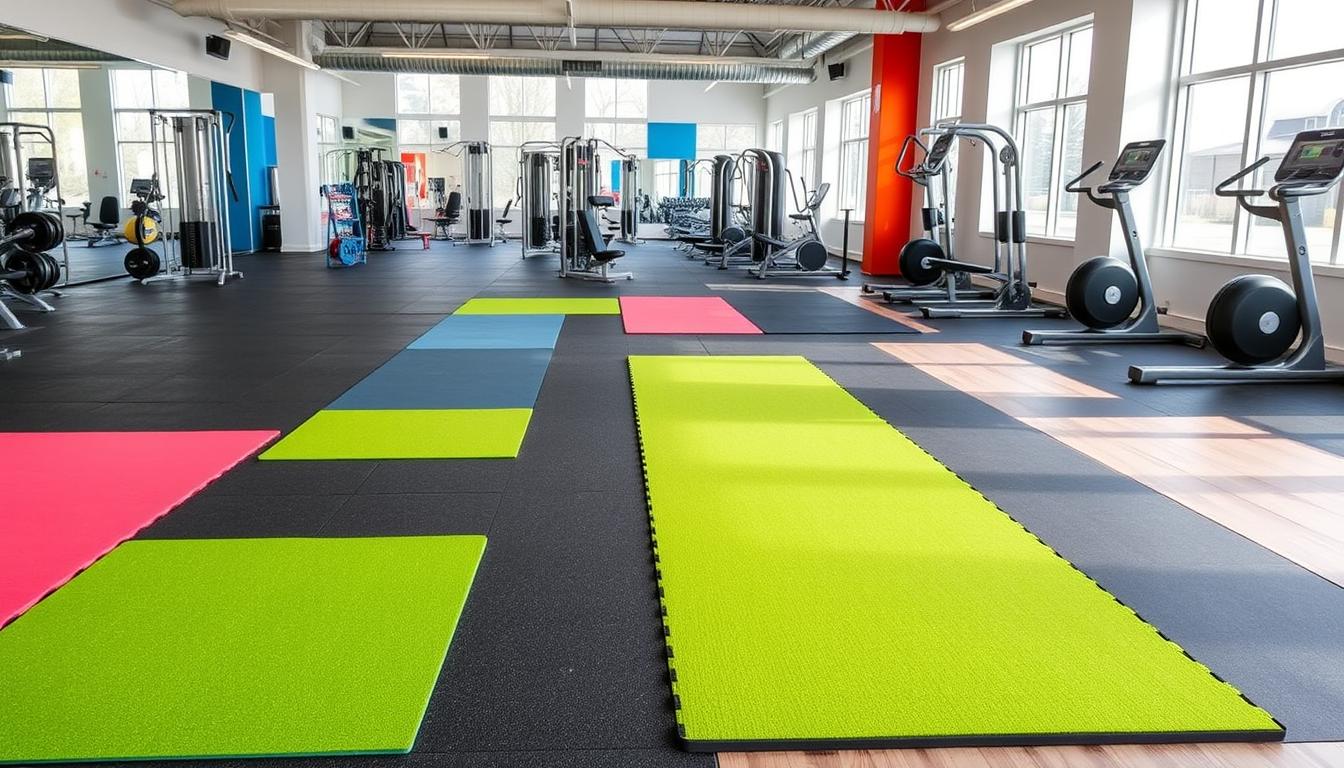As an athletic trainer, you’re key in keeping athletes and active people healthy. You help prevent injuries, treat them, and help people get back to their activities. Ever thought about how much you make compared to others in your field? This guide will explore how much athletic trainers earn, what affects their pay, and how to make more money.
In the U.S., athletic trainers earn an average of $50,546 a year. But, salaries can range from $39,000 to $68,000. This shows that many things can change how much you make, like your education, where you work, and the area you’re in.
Table of Contents
Understanding Athletic Trainer Roles
Athletic trainers are key healthcare professionals in sports and physical activities. They prevent, assess, treat, and rehabilitate injuries for athletes and non-athletes. They work in schools, colleges, professional sports, and industries, making them highly sought after.
What Does an Athletic Trainer Do?
Athletic trainers handle many tasks. They give emergency care, diagnose and treat injuries, and create rehab plans. They work with doctors, physical therapists, and others to help patients. They also prevent injuries by teaching athletes about warm-ups, cool-downs, and exercises.
Key Skills Required for Success
- Proficiency in emergency care and first aid
- Expertise in clinical diagnosis and assessment
- Therapeutic skills, such as manual therapy and therapeutic exercise
- Strong communication and interpersonal abilities
- Analytical thinking and problem-solving skills
- Knowledge of sports psychology and nutrition
To be an athletic trainer, you need a bachelor’s or master’s degree in athletic training or a related field. You also need certification from the Board of Certification (BOC). Many states require them to be licensed or certified, ensuring they meet care and expertise standards.

Athletic trainers are vital in promoting health and performance in athletes and active people. They focus on preventing, diagnosing, and rehabilitating injuries. They are in high demand in schools, colleges, professional sports, and industries.
Factors Influencing Athletic Trainer Pay
As an aspiring or current athletic trainer, it’s key to know what affects your pay. Your salary can change a lot based on where you work, your education, and your job type.
Geographic Location
Your location can greatly impact your salary. Major cities often pay athletic trainers more. For example, in Washington, D.C., the average salary is over $100,000, much higher than the national average.
Level of Education and Certification
Your education and certifications are very important for your salary. Since 2022, a master’s degree is needed for many jobs. Also, getting the Certified Athletic Trainer (ATC) credential can raise your salary by about $4,795.
Type of Employment
Where you work also affects your pay. Those in professional sports or private healthcare usually earn more than those in schools. This is because these places have more money and resources.
| Employment Setting | Average Annual Salary |
|---|---|
| Professional Sports | $68,040 |
| Private Healthcare Facilities | $65,500 |
| Educational Institutions | $47,713 |
Knowing these factors can help you make better career choices and negotiate your salary.

“The salary of an athletic trainer can vary significantly depending on their geographic location, education level, and the type of organization they work for.”
Average Athletic Trainer Salaries in the U.S.
In the United States, the average athletic trainer makes $57,238 a year. But, salaries can change a lot based on where you work, how long you’ve been doing it, and your job type. Let’s explore the average salaries across the country and how they differ based on experience.
Nationwide Salary Statistics
The average hourly wage for athletic trainers in the U.S. is $28. This can range from $23 to $33 an hour. On a monthly basis, the average trainer makes $4,770, ranging from $3,976 to $5,670.
Comparison by Experience Level
New athletic trainers with less than a year of experience make about $55,458 a year. Those with over 8 years of experience can earn around $60,037 annually. The median salary has dropped from $73,623 in 2023 to $72,722 in 2024, showing a competitive job market.
Salaries also vary by location. For example, trainers in San Francisco, CA, make an average of $71,548. In New York, NY, and Boston, MA, they earn $66,854 and $64,164, respectively.
| Experience Level | Average Annual Salary |
|---|---|
| Entry-level (under 1 year) | $55,458 |
| Experienced (over 8 years) | $60,037 |
The data shows athletic trainers are well-compensated, with a 9% increase in salary over the last 5 years. To get the best athletic trainer average pay and sports therapy wages, focus on improving your skills, getting certifications, and gaining experience.

Salary Differences by Industry
The industry you work in greatly affects your salary as an athletic trainer. Salaries vary widely, from schools to professional sports teams. Let’s look at the salary trends in different sports medicine sectors.
Salaries in Educational Institutions
Athletic trainers in schools and colleges earn a median of $59,890 a year. They often get benefits like health insurance and retirement plans. This makes these jobs very appealing to many in the field.
Salaries in Professional Sports
However, trainers for professional sports teams earn more. They make about $57,390 a year. They also get bonuses, incentives, and access to top-notch facilities.
| Industry | Median Annual Salary |
|---|---|
| Educational Services | $59,890 |
| Hospitals | $57,390 |
| Fitness and Recreational Sports Centers | $53,820 |
| Offices of Physical, Occupational and Speech Therapists, and Audiologists | $53,120 |
The data clearly shows how industry affects athletic trainer industry pay and sports medicine sector salaries. Those looking for higher pay might choose professional sports. But, those who value job stability and benefits might prefer educational institutions.
Impact of Specializations on Pay
Being an athletic trainer with a special focus can really up your pay. Certain areas like sports medicine or rehabilitation are in high demand. They often come with higher salaries.
Common Specializations in Athletic Training
- Sports Medicine
- Orthopedic Rehabilitation
- Pediatric Sports Therapy
- Geriatric Sports Therapy
- Nutrition and Performance
- Biomechanics and Movement Analysis
How Specializations Affect Salary
Athletic trainers with special skills can make over $70,000 a year. Getting extra certifications, advanced degrees, and more experience in a niche can increase your pay. Employers are willing to pay more for trainers who offer specialized care.

By choosing a specific sports therapy area, athletic trainers stand out in the job market. They can earn more sports therapy niche salaries. Getting specialized training and certifications is a smart way to boost your athletic trainer income.
Benefits and Compensation Packages
As an athletic trainer, you get more than just a salary. The average total cash compensation, including bonuses, is $54,329. Some trainers may also get profit-sharing benefits, ranging from $0 to $2,000, based on their performance.
Health Insurance and Retirement Plans
Most athletic trainers have health insurance. This includes medical, dental, and vision plans. Employers may also offer retirement plans like 401(k) or 403(b) accounts. These benefits can vary, so it’s important to review them carefully during the hiring process.
Bonuses and Other Incentives
Besides salary, athletic trainers can get bonuses and incentives. Bonuses can be between $480 and $3,000, depending on several factors. Some employers offer profit-sharing or performance-based rewards to show appreciation for your work.
To increase your earnings as an athletic trainer, research typical sports medicine compensation packages in your area. Negotiate for the best benefits. Knowing all about compensation and perks helps you make smart career choices and ensures fair pay for your skills and hard work.

“The best athletic trainers are not just skilled in sports medicine, but also understand how to negotiate for the right compensation package to support their long-term career and financial goals.”
Career Growth Opportunities in Athletic Training
As an athletic trainer, you can move up and earn more. Getting better at your job often means you get paid more. This lets you earn more money.
Advancement in Athletic Trainer Positions
One way to grow is to become a leader. You could be a head athletic trainer or an athletic director. These jobs pay more because they come with more work and leadership.
Transitioning to Related Fields
Trainers can also move into fields like physical therapy or sports medicine. These areas often pay well, especially in the private sector or with sports teams. Your skills in athletic training can lead to a fulfilling career in sports medicine.
Getting certifications can boost your career and pay. The National Athletic Trainers’ Association Board of Certification (NATABOC) or Certified Strength and Conditioning Specialist (CSCS) can make you more valuable. This is true in the athletic trainer career progression and sports medicine advancement.

Whether you stay in athletic training or move to a related field, keep learning. This is crucial for finding new opportunities and earning more. It’s key to your athletic trainer career progression.
Job Market Outlook for Athletic Trainers
The job outlook for athletic trainers in the U.S. is very good. The Bureau of Labor Statistics (BLS) says their jobs will grow by 14% from 2022 to 2032. This is much faster than most jobs. This growth comes from more people knowing about sports injuries and athletic trainers’ roles in healthcare.
Current Demand for Athletic Trainers
In January 2023, there were 56,906 Certified Athletic Trainers in the U.S., the Board of Certification for the Athletic Trainer (BOC) reports. The BLS says there are 33,800 athletic trainer jobs. Zippia thinks there are over 25,119 jobs. The field is almost evenly split between men and women, with an average age of 40.
Future Trends in the Profession
- The number of Certified Athletic Trainers is expected to grow by the end of 2023, the BOC says.
- More athletic trainers are working outside traditional sports settings. They help prevent injuries and save money for companies.
- The job outlook for athletic trainers is strong. There will be about 2,700 new jobs each year.
- Athletic trainers are needed in many places. This includes colleges, professional sports teams, hospitals, schools, and more.
The job market for athletic trainers in the U.S. looks very promising. There’s a growing need for their skills in sports medicine. As more people understand the importance of sports medicine, athletic trainers will have even more job opportunities in the future.

Professional Organizations and Resources
Being an athletic trainer means staying connected with key professional groups and resources. These groups offer great networking chances and access to ongoing education. This can boost your skills and knowledge.
Leading Organizations for Athletic Trainers
- National Athletic Trainers’ Association (NATA) – The top group for athletic trainer associations, NATA supports its members with advocacy, education, and resources.
- Board of Certification for the Athletic Trainer (BOC) – The BOC certifies athletic trainers and ensures they meet high standards.
- National Strength and Conditioning Association (NSCA) – The NSCA is all about sports medicine professional development. It offers special certifications and educational programs for athletic trainers.
Networking and Continuing Education Opportunities
Joining these organizations opens doors to networking and learning. You can attend conferences, webinars, and workshops. These events let you meet peers, learn from experts, and keep up with new trends in athletic training.
By getting involved with these resources, you can improve your skills and knowledge. This can lead to better career opportunities and higher pay. Investing in your growth is crucial for increasing your earnings as an athletic trainer.
“Continuous learning and professional development are essential for athletic trainers to stay competitive and provide the best possible care for their athletes.”
How to Maximize Your Earnings as an Athletic Trainer
As an athletic trainer, you can have a fulfilling and profitable career. Focus on learning more, getting extra certifications, and honing your skills. This way, you can earn more and open up new career paths.
Negotiating Salary and Benefits
Good salary negotiation is key for athletic trainers. Talk about more than just your base salary. Ask for bonuses, retirement plans, and money for professional growth. Show your worth by talking about your success with patients and new ideas in sports therapy.
Knowing how to manage your money is also important. Learn about what others in your field make. Be ready to explain why you deserve more based on your experience, skills, and where you live.
Continuing Education and Certifications
Investing in your growth is a smart move. Get more certifications, like those from the National Athletic Trainers’ Association (NATA). This shows you’re dedicated to being the best. Also, go to conferences and workshops to learn more and meet others in your field.
Keeping your skills sharp can lead to better jobs and higher pay. This could mean learning new rehab methods, sports psychology, or becoming an expert in a certain sport or group of patients.
By using your education, certifications, and skills, you become a top choice in sports therapy. This can help you negotiate a better salary.
Conclusion: Making Informed Career Decisions
Summary of Key Points
Athletic training is a fulfilling career with good pay and job chances. The average salary is $54,283, but it can grow with experience and education. The field is expected to grow by 14% by 2032, showing a bright future.
Final Thoughts on Athletic Trainer Pay
Things like where you work, the industry, and extra certifications affect your pay. As sports evolve, knowing the latest trends helps in your career. Understanding what affects your pay lets you plan for success and earn more in this rewarding field.














Athletic Girl: Tips for Building Strength & Confidence
[…] athletic girl is a unique and captivating individual. She has a remarkable physique and a strong commitment to […]